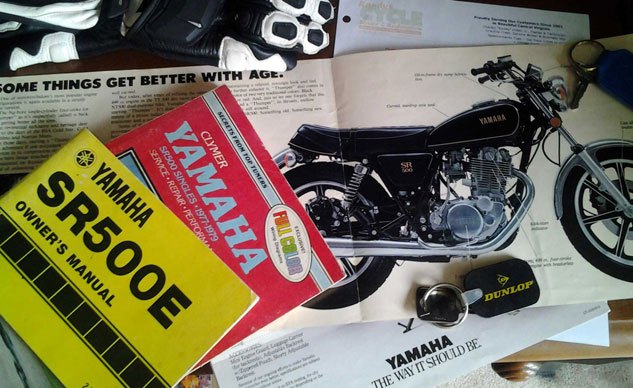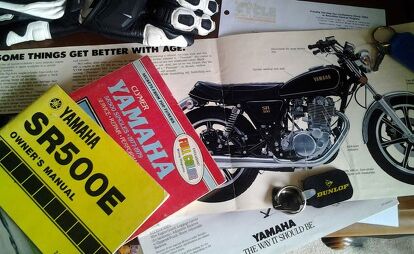Head Shake - The Right Tool for the Right Job
I had the good fortune to be standing in a driveway in Northern Virginia last year staring at what appeared to be a box-stock, showroom condition, 1978 Yamaha SR500. Yamaha introduced the big thumper in ’78 but it was meant to evoke images of the earlier BSA Gold Star, G-50 Matchless, and Norton Manx, big sporting singles that had preceded it from a bygone, kick-start only, era. A time when men wore porridge pot helmets and had square cut jaws and steely faced grimaces that prevailed in places like the Isle of Man, or at Normandy and El Alamein as the case may be, if their racing season was interrupted by unpleasantness on the continent. This particular pristine big single had been purchased by its original owner 35 years ago from CycleSport in Northern Virginia, and here, several thousand miles and three and a half decades later, I had just bought it, along with an impressive collection of spares.
I was familiar with CycleSport in Northern Virginia as I had also once stood in their driveway, coincidentally enough also 35 years previous. And I was also purchasing a new motorcycle at that time. And maybe most oddly of all, it was also a brand new, first year, 1978 Yamaha SR500. This black one I was staring at now, this time capsule, could have sat in the showroom next to the bright red one I rode away on back in ’78 for all I know. If Yamaha had meant to evoke images of a bygone era with the introduction of the SR, they had succeeded admirably, it had worked on me back then, and it was certainly working on me in the year 2013, albeit the bygone era in this instance was the Carter administration and my youth.
A lot had changed in 35 years. Northern Virginia had ballooned into one enormous high rise squirrel’s nest of HOV and HOT lanes, defense contractors, Beltway-bandits, and IT companies, encircled by pho shops and Bed, Bath and Beyonds, with traffic to rival LA. I was festooned in Vanson, Arai, and Alpinestars’ best rather than Frye boots, two-tone Bates gloves, an old deer skin jacket I had lifted off my old man, and the classic, “If you have a 10 dollar head, buy a 10 dollar helmet,” Bell Star lid with the snap-down visor and homemade cheek pads to keep the thing from trying to garrote me at speed. But the SR sitting in front of me was frozen in time. It was even shod with a Dunlop TT100 on the front – the first production tire to ever lap the Isle of Man at over a ton back in 1969 – and a Dunlop K-81 Roadmaster on the rear. The tires looked to all the world much like the Bridgestone Mag Mopus tires that had come with the bike when brand new. We had come full circle; I was back where I had started.
Applying everything I had learned, only half of which I had actually retained, I reasoned that the local cops back home would find the bike disarming. The old thumper qualifies for historic tags due to its age. If I don’t shave, I look historic. Together we would appear unable to violate any posted speed limits of any consequence whatsoever. This is good. My current ride by way of comparison is a modified Honda RC-51, it’s an outstanding – albeit porky – bull in a Southern Maryland china shop, and can double the speed limits of the majority of our public roads in first gear. I hail from the smallest county in Maryland, a land of peninsulas. We are surrounded by water on three sides. As a consequence most of our roads go nowhere, they are largely one lane, no outlet, paved goat trails ending at a pier. The exception being what is referred to locally as, “Mig Alley,” or Maryland Route 4 for the uninformed, a piece of asphalt that seems irresistible to every car in the county with a light bar and a siren on it. If the Coen Brothers ever want to film, “No Country for Big Fast Bikes,” I have the perfect location for them. This is big single country if one prefers to avoid dates in district court, and the back roads and broken tarmac beg for superbike bars, not clip-ons.
I have a long history with SRs, almost all born out of necessity. When I bought the first one back in ’78, the twin to this most recent one I had just purchased, the decision was spurred on by a fantastic article in Car and Driver, a car magazine of all things, and by automobile insurance premiums which had reached critical mass. One more car accident and the insurance cabal would take away my skateboard and see to it that I was kept at a safe distance from all forms of transportation to include, “Public.” But here’s the beauty of it, motorcycle insurance rates? They were unaffected by such four wheeled transgressions, it was like a fresh start, on two wheels no less, what could be better?
My first road trip of consequence on that stock SR was to Ocean City, Maryland. A quick summer jaunt to chase girls and drink beer before leaving for the Army. That thumper took me to West Virginia; to Summit Point Raceway, to the cliffs at Seneca Rocks, places of speed and freedom, as well as more mundane locales like school and work. Spring, summer, winter, and fall, the SR500 hooked me on bikes, well, maybe more accurately; the SR and State Farm Insurance hooked me on bikes.
I bought a second SR after I got out of the Army and was going to college. The first one had met an untimely demise in my absence at the hands of a well-intentioned friend trying to exercise it, and an errant station wagon. No matter, I had the harebrained idea to go racing (see: Headshake – Did Not Start), but I had no money, no sense, and no track-suitable bike that I could pitch down the tarmac with impunity. I needed my Honda 750 for work and college so I wasn’t safety wiring that up. I wasn’t looking for an SR, I was just looking for cheap. I actually figured an RD350 or 400 would pop-up. And then out of the blue a used SR was listed in the local classifieds, and the rest is five dollar WERA road racing trophy history. That little SR was the racing, “gateway drug,” that led to RZs, FZRs, GSX-Rs, and a whole host of others, all with more of everything except character. Synchronicity strikes again.
After a decade and a half, I took a hiatus from racing for a while. I’d had my fun and life had other demands. Then, a few years ago, my old friend Rich lured me back to the track, making an offer that I could not refuse: “Just show up at the track, bring your helmet, bring your leathers, bring your license, and just ride,” he would repeat ad nauseam in his parade ground voice. So finally I did, showing up at a track I’d never seen, to ride a bike I’d never ridden, without any preconceived notion whatsoever of how things would go, and we did great that weekend. I remembered everything I loved about racing and the people, and yes, the bike … Rich’s own highly modified SR500.
I had ridden a few variations of the big singles Rich had prepared over the years, several of which boasted some pretty impressive hardware; Axtell heads, ported heads from Zipper’s, a Harley shop that had built championship winning drag bikes, frames with altered steering head geometry and any number of intake and exhaust configurations. These bikes are, if nothing else, overachieving, resilient little machines. They’re tough, they exude character, and they grow on you.
Which brings us back to my recent purchase: In stock form there is one thing that SR500s are not and that is fast. This realization came flooding back to me as soon as I ran through the gears on the trip home with my shiny new/old acquisition.
But SRs do respond magnificently to modifications, and I already had a “fix” in mind, several actually, waiting for us back at the house.
An old Supertrapp exhaust system loitered in the basement, Renthal bars, a 36mm straight pull Mikuni with the obligatory K&N air filter and crankcase breather filters … the better to ditch the air box with, a Motion Pro turbo throttle, progressive fork springs and shocks, braided steel brake lines, and some old NIB Ferodo pads I had laying about. The bike could wait a riding season for whatever today’s equivalent of a Wiseco 10.5:1 piston, WB-2 cam, and valve springs are. And I’d wrap up all the stock parts, of course, so it could be returned to stock form.
All’s I need now is a Telefix fork brace and an oil cooler, throw my little SR and I into the Way-Back machine, and we’ll grid-up in the now defunct WERA E-Superbike class.
In a lifetime filled with what some might rightfully call “imprudent” purchases, an SR 500 has never been one of them. Like Zippo lighters, Snap-On wrenches, and Colt 1911s, they just work. And just like when I first started riding on the street, or started racing, or returned to racing, back then just as now, it’s the right tool for the right job, and oddly enough – expected or not – always at the right time.
Parking lots in Northern Virginia, kickstart-only big singles, round and round we go, makes as much sense as anything else I guess. Everything I love the most seems to involve going in circles only to end up in the same place again at a fairly good clip. Call me single-minded but it usually works out pretty good. Follow your heart, but pass that damned guy in front of you! We’ll see you in the pits!
About the Author: Chris Kallfelz is an orphaned Irish Catholic German Jew from a broken home with distinctly Buddhist tendencies. He hasn’t got the sense God gave seafood. Nice women seem to like him on occasion, for which he is eternally thankful, and he wrecks cars, badly, which is why bikes make sense. He doesn’t wreck bikes, unless they are on a track in closed course competition, and then all bets are off. He can hold a reasonable dinner conversation, eats with his mouth closed, and quotes Blaise Pascal when he’s not trying to high-side something for a five-dollar trophy. He’s been educated everywhere, and can ride bikes, commercial airliners and main battle tanks.
More by Chris Kallfelz











































Comments
Join the conversation
Yawn